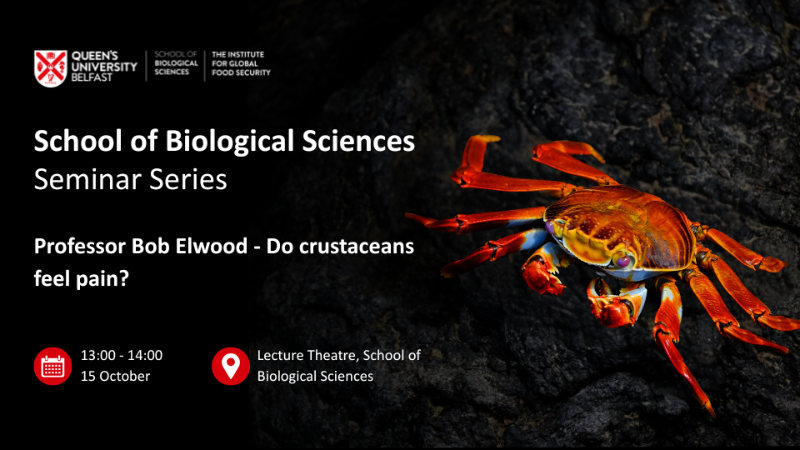We are pleased to welcome Professor Bob Elwood, Emeritus Professor of Animal Behaviour, Queen’s University Belfast, to the School to share his latest research in distinguishing nociceptive reflexes from pain in crustaceans, or other animals.
- Date(s)
- October 15, 2025
- Location
- Lecture Theatre, School of Biological Sciences
- Time
- 13:00 - 14:00
Professor Elwood is Emeritus Professor of Animal Behaviour, Queen’s University Belfast. He started his lectureship in Zoology in October 1975 and has since followed broad interests in behaviour, including factors that control paternal care and inhibit infanticide in mammals, how animals make decisions in fights for resources. His interest in potential pain in crustaceans followed a chance meeting with a well-known seafood chef, who asked if they felt pain.
Bob has published over 200 papers and book chapters, was Treasurer and then President of the Association for the Study of Animal Behaviour. He has held editorial roles with Animal Behaviour, Biology Letters and Journal of Zoology, has supervised 40+ PhD students, and devised and taught an MSc programme in animal behaviour and welfare. He was elected to the Royal Irish Academy, awarded the ASAB medal, received the BSAS/RSPCA prize for innovative developments in animal welfare, and the UFAW medal for outstanding contributions to animal welfare science.
Abstract: Do crustaceans feel pain?
All animals are prone to tissue damage, and they typically have rapid nociceptive reflexes that enable the animal to withdraw from the damaging stimuli. These reflexes are effective in reducing immediate tissue damage. However, at least in humans, there is a second response to tissue damage that we call pain. The emotional experience of pain is generated in the brain and appears to cause long-term changes in motivation that modify behaviour. Pain thus enhances long-term protection so that the animal avoids situations that previously resulted in tissue damage and pain. The negative affective state of pain might also guide responses towards the specific site of a wound that enhance recovery.
This presentation considers criteria that might help to distinguish nociceptive reflexes from pain in crustaceans (or other animals). Rapid avoidance learning and prolonged memory indicate central processing rather than mere reflexes and are consistent with the experience of pain. Complex, prolonged directed grooming or rubbing demonstrate an awareness of the specific site of stimulus application. Trade-offs with other motivational systems indicate central processing, and these demonstrate that responses go beyond reflexes. Further, long-term changes in behaviour following a noxious experience can last for at least 24hrs, which is not consistent with reflex responses. The data of these experiments go beyond the idea of just nociception but do not provide total proof of pain. The idea of pain in crustaceans is still disputed by some. Despite some vigorous objections the increasing evidence that is consistent with the idea of pain is changing attitudes. There is an increasing acceptance that these animals might experience pain, and the UK Law has changed to consider welfare of crustaceans. The food industry is now considering the possibility of pain and suffering of decapods and there are moves to avoid dismembering or boiling live animals without prior stunning. Billions of animals each year are subject to better treatment following the experiments conducted at Queen’s University, Belfast.
- Department
- School of Biological Sciences
- Add to calendar

